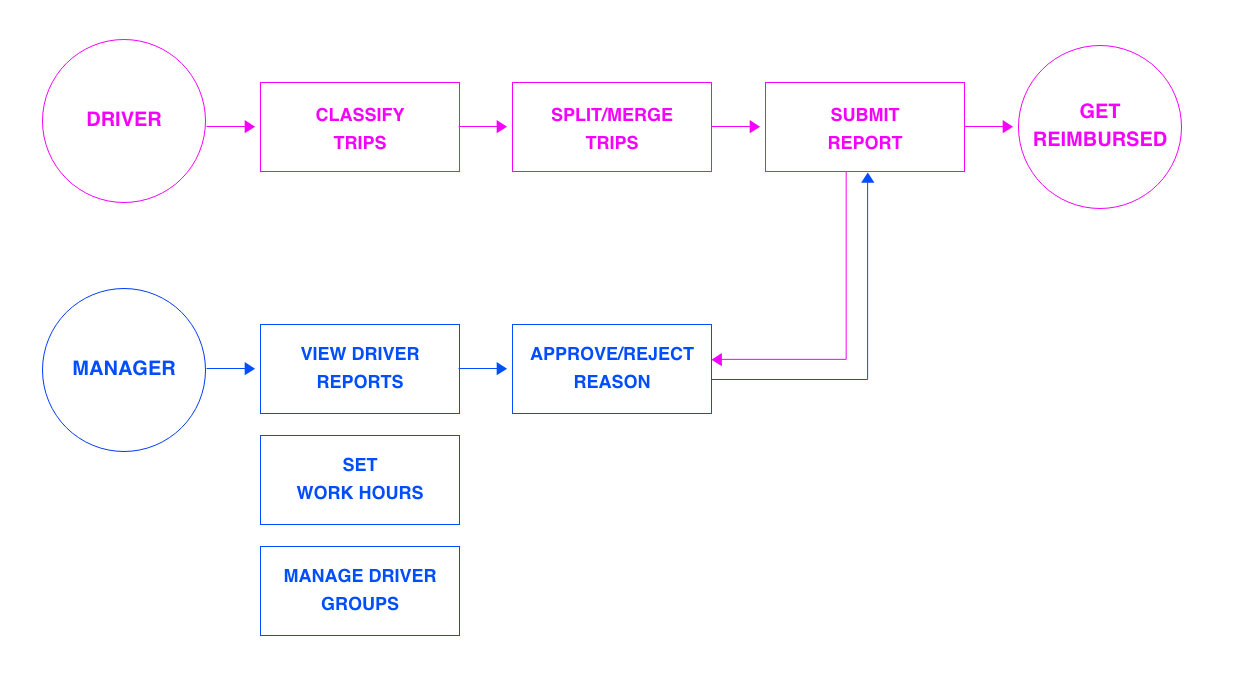My Role
Senior UX Designer
Skills
UX Strategy, Research, UI Design
Client
Autotrip UK

Driver’s throughout the UK are using various methods to capture business mileage, from logbooks and written notes to excel spreadsheets and google maps. These methods are both time-consuming and often not accurate, trips are easily missed or distances are not measured accurately. Driver’s are not able to claim the full amount and are also not HMRC compliant when submitting reports.
To make Autotrip’s product more accessible to driver’s facing these problems, a mobile app version of their B2B & B2C SAAS platform & GPS tracking device needed to be developed to meet business goals of increasing subscription signups. My role was to set up designing thinking process by defining key personas, map out the various user journeys and create wireframes to validate the hypothesis using user research and iterating based on feedback.
UX Process
Firstly I applied Human-Centered Design and Lean UX processes to make sure that we prioritised the right features and my design decisions were supported by research and feedback from drivers and key stakeholders within the business.

Building Personas & Empathy Maps
During internal workshop sessions, I created personas and empathy maps, helping the team visualise the main types of drivers and sharing an understanding of their emotions and pain points.
By building empathy we all start to understand the driver’s behavior, identifying problems we need to solve and guide us to meaningful innovation. As the project progresses I revise and adjust the personas and empathy maps based on actual research data.


Defining User Stories & Ideating User Journeys
During internal workshops with key stakeholders I mapped out a user stories and a high level user journey which was used to create lo-fi wireframes of the screens needed with key functionality required.


User Research & Hypothesis Validation
I worked with an research agency to source a database of 500 drivers throughout the UK who currently submit business mileage claims. I worked on a survey together with stakeholders and build a lo-fidelity prototype to include to validate the user journeys and functionality. After recieving all the data I presented to everyone showing the feedback we got. Overall drivers like the idea and said it they would definetly use the app, it was also interesting that a lot of users were using Google Maps, so this was something I kept in mind while designing the live view & trips page to fit in with the user's mental model. There was also additional functionality we identified that we could include in future iterations.


Product Strategy
From research gathered we can now understand as a team who we are desigining for and the problems we are trying to solve. Defining the product vision and how we will measure success.

Rapid Prototyping & Atomic Design System
I started designing specific sections of the product according to the user flow diagram. Designs were prepared in the form of click-through prototypes for feedback from stakeholders & users.
Interface elements were simultaneously added to the design system with the atomic approach. Setting up a global design system allowed me to make system-wide changes quickly during the iteration process.
Rapid prototyping allowed for quick usability testing and reiteration. Modern design tools like Adobe XD and Zeplin allowed me for flawless delivery of the layouts and design system to the development team.
Blues and green were used to convey trust and freshness, as we wanted to differentiate from competitors, copy was informal and unique to the Autotrip brand.
Delivery, Future Roadmap & Reflection
I worked closely with the dev team to ensure a smooth design-into-code transition. I also performed design QA on the developed product to make sure it met the design specifications.
Based on feedback during research I was also able to assist in prioritising features that would satisfy both user and business goals and define the future roadmap.
Working on an end to end product design process within a cross functional team was a chance for me to really refine the product development process. Building a design library to rapidly create functionality to test, implementing user research to confirm if functionality really solves a pain point then iterating based on feedback from stakeholders and users.

